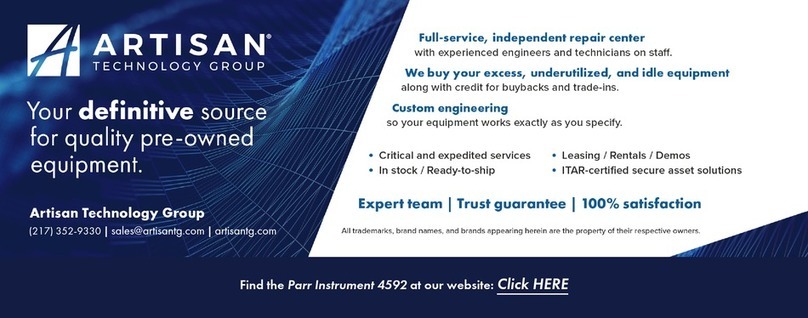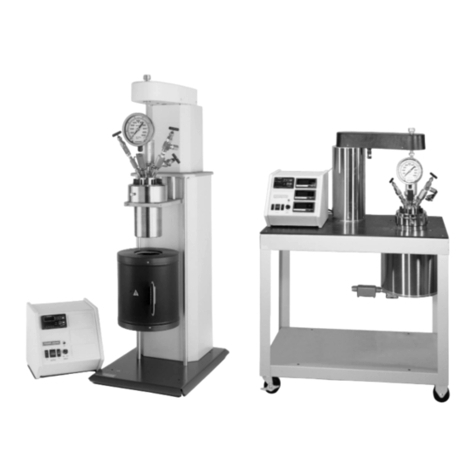
General Purpose Pressure Vessels
www.parrinst.com
5
User’s Responsibility
All Parr Reactors and pressure vessels are designed
and manufactured with great care to assure safe
operation when used within their prescribed tem-
perature and pressure limits. But . . . the basic
responsibility for safety when using this equipment
rests entirely with the user; who must:
1. Select a reactor or pressure vessel which has the
capability, pressure rating, corrosion resistance
and design features that are suitable for its in-
tended use. Parr engineers will be glad to dis-
cuss available equipment and material options
with prospective users, but the final responsi-
bility for selecting a reactor or pressure vessel
that will perform to the user’s satisfaction in any
particular reaction or test must rest with the user
– not with Parr.
In exercising the responsibility for the selection
of pressure equipment, the prospective user
is often faced with a choice between over- or
under-designed equipment.The hazards intro-
duced by under-designed pressure vessels are
readily apparent, but the penalties that must
be paid for over-designed apparatus are often
overlooked.
Recognizing these criteria, Parr reactors and
pressure vessels are offered in several different
styles, each designed for convenient use in daily
operation within certain temperature and pres-
sure limits, using gaskets, closures and other
elements carefully selected for safe operation
within the limits specified for that design. But in
order to preserve the validity of these designs,
all temperature and pressure limits must be
observed, and no attempt should be made to
increase these limits by making alterations or by
substituting components which are not recom-
mended by Parr Instrument Company.
2. Install and operate the equipment within a
suitable barricade, if required, with appropriate
safety accessories and in full compliance with
local safety codes and rules.
All standard Parr pressure vessels are provided
with either a suitable relief device or a means
to attach one (typically in the form of a plugged
opening). When a pressure vessel is delivered
without a pressure venting device, it is the cus-
tomer’s responsibility to provide pressure relief
in order to protect the operator and the equip-
ment from destructive high pressures. If you
need more information or need help in selecting
a proper relief device, please contact Parr Instru-
ment Company.
3. Establish training procedures to ensure that any
person handling the equipment knows how to
use it properly.
4. Maintain the equipment in good condition and
establish procedures for periodic testing to be
sure the vessel remains structurally sound.
Pressure and Temperature Limits
The working pressure and temperature at which any
reactor or pressure vessel can be used will depend
upon the design of the vessel and the materials
used in its construction. Since all materials lose
strength at elevated temperatures, any pressure
rating must be stated in terms of the temperature at
which it applies. The standard material of construc-
tion for Parr Instrument Company isType 316 Stain-
less Steel.
Limits for vessels made of other materials and for
other operating temperatures can be obtained from
Parr Customer Service. No attempt should be made
to increase these limits by making alterations or by
substituting components that are not recommended
by the Parr Instrument Company. It must also be
understood that lower pressure and temperature
limits may be required for modified reactors and for
vessels made of special alloys.
Limits for vessels will be determined by the physi-
cal characteristics of the vessel material and will be
prescribed on an individual basis.
The maximum working pressure and temperature
for any vessel is governed by the design of the
vessel and the strength of the material from which
it is constructed. There is also a close relationship
between working pressure and temperature since
the strength of any material will normally fall off
as the temperature is increased. Temperature and
pressure limits are also affected by the physical
properties and temperature limits of the gaskets and
seals used in the vessel, and by any valves, gages
or other fittings attached to the vessel. Obviously,
the safe operating pressure of any system can be no
higher than that of its lowest rated component.
All Parr reactors show the maximum safe operating
pressure and temperature imprinted on the cylinder.































